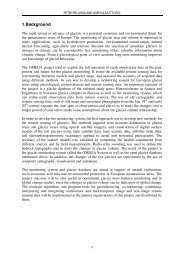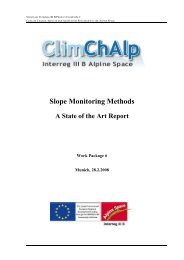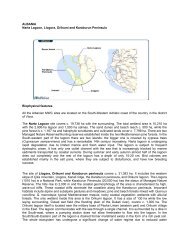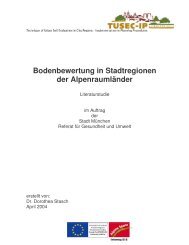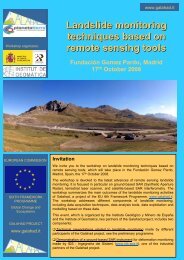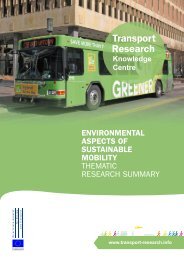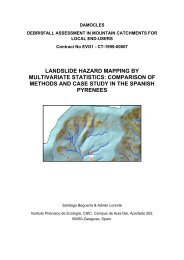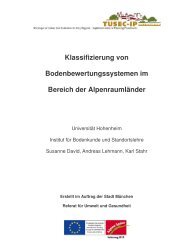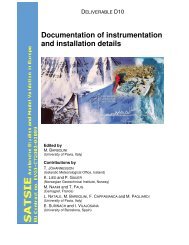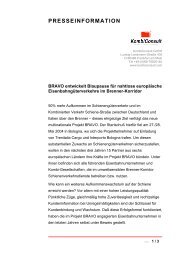Deliverable D3.1.2 Key products of the forest-based industries and ...
Deliverable D3.1.2 Key products of the forest-based industries and ...
Deliverable D3.1.2 Key products of the forest-based industries and ...
Create successful ePaper yourself
Turn your PDF publications into a flip-book with our unique Google optimized e-Paper software.
<strong>Key</strong> <strong>products</strong> <strong>of</strong> <strong>the</strong> <strong>forest</strong>-<strong>based</strong> <strong>industries</strong><strong>and</strong> <strong>the</strong>ir dem<strong>and</strong>s on wood raw material properties• Knot size <strong>and</strong> status: The size <strong>of</strong> knots, <strong>the</strong> area <strong>the</strong>y occupy as a ratio <strong>of</strong> <strong>the</strong> area <strong>of</strong> <strong>the</strong> solidtimber (KAR) <strong>and</strong> <strong>the</strong>ir status (dead or alive) have important consequences for <strong>the</strong> usability <strong>of</strong>timber. Knots are a key characteristic that defines <strong>the</strong> visual grading <strong>of</strong> timber into differentcategories. Knots also have important consequences for wood strength because <strong>the</strong> presence<strong>of</strong> knots leads to grain distortion <strong>and</strong> strength reduction (clear wood with no knots can be twiceas strong as a typical piece <strong>of</strong> sawn timber). Dead knots which may fall out <strong>of</strong> sawn timber willdisqualify its use in joinery, cladding, veneer, parquet etc.• Grain angle: The fibres in timber are approximately aligned along <strong>the</strong> tree axis. However,deviation from this axis reduces <strong>the</strong> stiffness <strong>of</strong> <strong>the</strong> timber <strong>and</strong> increases its tendency to twistduring drying. Grain angle varies from pith to bark usually increasing rapidly in <strong>the</strong> first fewyears <strong>of</strong> growth <strong>and</strong> <strong>the</strong>n decreasing slowly <strong>and</strong>, if <strong>the</strong> tree is old enough, reversing direction.Grain angle is a function <strong>of</strong> species, growth rate <strong>and</strong> exposure to <strong>the</strong> wind. Trees planted atwider spacings or in windy locations will generally have higher grain angles.• Micr<strong>of</strong>ibril Angle (MFA): The middle layer <strong>of</strong> <strong>the</strong> secondary cell wall <strong>of</strong> wood cells is dominatedby cellulose micr<strong>of</strong>ibrils wound in a helix. The angle <strong>of</strong> <strong>the</strong>se micr<strong>of</strong>ibrils in relation to <strong>the</strong> longaxis <strong>of</strong> <strong>the</strong> cell has pr<strong>of</strong>ound consequences for <strong>the</strong> stiffness <strong>of</strong> <strong>the</strong> wood, with angles close tozero giving <strong>the</strong> stiffest wood. Micr<strong>of</strong>ibril angle varies from pith to bark with generally highervalues close to <strong>the</strong> pith <strong>and</strong> lower values in <strong>the</strong> more mature wood towards <strong>the</strong> bark. Micr<strong>of</strong>ibrilangle is also affected by <strong>the</strong> presence <strong>of</strong> reaction wood with compression wood ingymnosperms having higher values <strong>and</strong> tension wood in angiosperms having very low values.• Reaction wood: In gymnosperms compression wood is produced to direct stems <strong>and</strong> branchesinto <strong>the</strong> desired orientation to access light. Compression wood is highly lignified with rounded,thick walled cells <strong>and</strong> high micr<strong>of</strong>ibril angles. Typically it is denser <strong>and</strong> more brittle than normalwood. The presence <strong>of</strong> compression wood in a piece <strong>of</strong> timber can lead to bow <strong>and</strong> springduring distortion due to <strong>the</strong> lignified cells having higher longitudinal shrinkage during drying.Tension wood is <strong>the</strong> equivalent form <strong>of</strong> reaction wood in angiosperms. It is characterised bylower lignin content <strong>and</strong> higher cellulose levels than normal wood <strong>and</strong> a gelatinous G-layerforms in <strong>the</strong> centre <strong>of</strong> <strong>the</strong> cells. Micr<strong>of</strong>ibril angles are generally lower than in normal wood. Dueto its high longitudinal shrinkage it is also liable to lead to distortion in drying timber.• Hardness: The hardness <strong>of</strong> <strong>the</strong> wood (i.e. its ability to take punishment) can be a very criticalrequirement in uses with high wear <strong>and</strong> tear such as flooring. Hardness will be primarily afunction <strong>of</strong> species <strong>and</strong> growth rate <strong>and</strong> is related to wood density.• Appearance: The visual appearance is important for a number <strong>of</strong> applications, particularlythose with high value. The characteristics <strong>of</strong> importance for appearance vary with <strong>the</strong>application but will be a function <strong>of</strong> knot size <strong>and</strong> status, grain angle, location within <strong>the</strong> stem(sapwood/heartwood) <strong>and</strong> <strong>the</strong> presence <strong>of</strong> any stain. In some circumstances a property suchas wavy grain will be highly desirable in one application but not in ano<strong>the</strong>r.19




